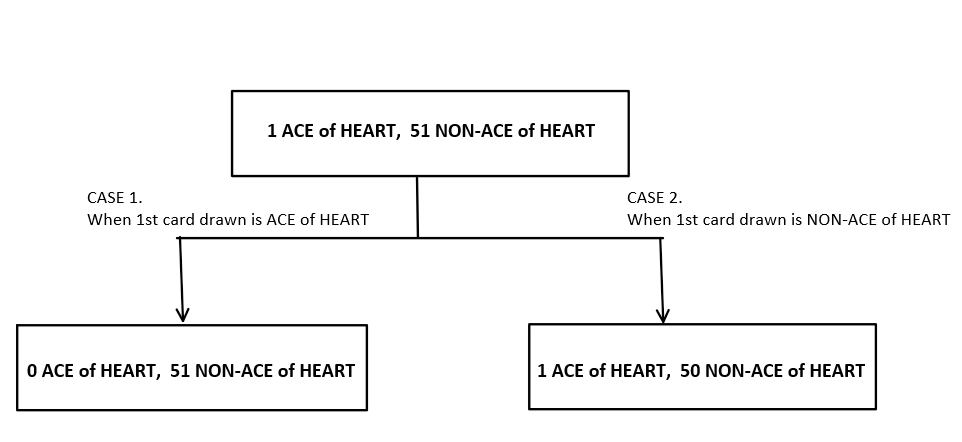
Two Cards are drawn without replacement from a well-shuffled pack. Find the probability that one of them is an ace of heart.
A. $\dfrac{1}{{25}}$
B. $\dfrac{1}{{26}}$
C. $\dfrac{1}{{52}}$
D. None of these
Answer
218.1k+ views
Hint: In the case of probability without replacement, the events occurring are referred to as dependent events i.e., in the given problem, the second event is dependent on the first event. Therefore, we need to evaluate the probability of the first event only after which the required probability will be calculated as per the question.
Formula Used:
The basic formula used for evaluating probability here is:
$Probability{\text{ }}of{\text{ }}getting{\text{ }}an{\text{ }}outcome = \dfrac{{Number{\text{ }}of{\text{ }}getting{\text{ }}favorable{\text{ }}outcome}}{{Total{\text{ }}Number{\text{ }}of{\text{ }}outcomes}}$
Complete step by step solution:
We know that, the total number of cards in a well-shuffled pack $(N) = 52$cards.
And, in a pack of 52 cards, there is only $1$ Ace of Heart and the remaining 51 are non-Ace of Heart.
Let ${E_1}$be the event of getting an Ace of Heart and ${E_2}$ be the event of getting non-Ace of Heart cards.
Now, we know $P = \dfrac{E}{N}$, where,
P = Probability of getting an outcome
E = Number of getting favorable outcomes
N = Total Number of outcomes
Therefore, the probability of getting an Ace of Heart is $P({E_1}) = \dfrac{{{E_1}}}{N} = \dfrac{1}{{52}}$
And, Probability of getting non-Ace of Heart is $P({E_2}) = \dfrac{{{E_2}}}{N} = \dfrac{{51}}{{52}}$

Now, According to Question (ATQ), there will be 2 cases (illustrated in the figure): -
Case1. When 1st card is drawn is ACE of HEART and the 2nd will be non-ACE of HEART
Probability (of getting the first card is ace of heart and the second is non-ace of heart) = $P(A) = \dfrac{1}{{52}} \times \dfrac{{51}}{{51}} = \dfrac{1}{{52}}$
Case2. When 1st card is drawn is non-ACE of HEART and the 2nd will be ACE of HEART
Probability (of getting the first card is non-ace of heart and the second is ace of heart) = $P(B) = \dfrac{{51}}{{52}} \times \dfrac{1}{{51}} = \dfrac{1}{{52}}$
Thus, the required probability is:
$P(E) = P(A) + P(B) = \dfrac{1}{{52}} + \dfrac{1}{{52}} = \dfrac{2}{{52}} = \dfrac{1}{{26}}$
Hence, the correct option is: (B) $\dfrac{1}{{26}}$.
Note: Since the problem is based on Probability without replacement which means an item cannot be drawn more than once hence, it is very necessary to analyze the given conditions carefully and the study of both the cases must be done precisely to find the accurate solution. Calculations must be performed very carefully.
Formula Used:
The basic formula used for evaluating probability here is:
$Probability{\text{ }}of{\text{ }}getting{\text{ }}an{\text{ }}outcome = \dfrac{{Number{\text{ }}of{\text{ }}getting{\text{ }}favorable{\text{ }}outcome}}{{Total{\text{ }}Number{\text{ }}of{\text{ }}outcomes}}$
Complete step by step solution:
We know that, the total number of cards in a well-shuffled pack $(N) = 52$cards.
And, in a pack of 52 cards, there is only $1$ Ace of Heart and the remaining 51 are non-Ace of Heart.
Let ${E_1}$be the event of getting an Ace of Heart and ${E_2}$ be the event of getting non-Ace of Heart cards.
Now, we know $P = \dfrac{E}{N}$, where,
P = Probability of getting an outcome
E = Number of getting favorable outcomes
N = Total Number of outcomes
Therefore, the probability of getting an Ace of Heart is $P({E_1}) = \dfrac{{{E_1}}}{N} = \dfrac{1}{{52}}$
And, Probability of getting non-Ace of Heart is $P({E_2}) = \dfrac{{{E_2}}}{N} = \dfrac{{51}}{{52}}$

Now, According to Question (ATQ), there will be 2 cases (illustrated in the figure): -
Case1. When 1st card is drawn is ACE of HEART and the 2nd will be non-ACE of HEART
Probability (of getting the first card is ace of heart and the second is non-ace of heart) = $P(A) = \dfrac{1}{{52}} \times \dfrac{{51}}{{51}} = \dfrac{1}{{52}}$
Case2. When 1st card is drawn is non-ACE of HEART and the 2nd will be ACE of HEART
Probability (of getting the first card is non-ace of heart and the second is ace of heart) = $P(B) = \dfrac{{51}}{{52}} \times \dfrac{1}{{51}} = \dfrac{1}{{52}}$
Thus, the required probability is:
$P(E) = P(A) + P(B) = \dfrac{1}{{52}} + \dfrac{1}{{52}} = \dfrac{2}{{52}} = \dfrac{1}{{26}}$
Hence, the correct option is: (B) $\dfrac{1}{{26}}$.
Note: Since the problem is based on Probability without replacement which means an item cannot be drawn more than once hence, it is very necessary to analyze the given conditions carefully and the study of both the cases must be done precisely to find the accurate solution. Calculations must be performed very carefully.
Recently Updated Pages
Chemical Properties of Hydrogen - Important Concepts for JEE Exam Preparation

JEE General Topics in Chemistry Important Concepts and Tips

JEE Atomic Structure and Chemical Bonding important Concepts and Tips

JEE Amino Acids and Peptides Important Concepts and Tips for Exam Preparation

JEE Extractive Metallurgy Important Concepts and Tips for Exam Preparation

Algebra Made Easy: Step-by-Step Guide for Students

Trending doubts
JEE Main 2026: Application Form Open, Exam Dates, Syllabus, Eligibility & Question Papers

Derivation of Equation of Trajectory Explained for Students

Hybridisation in Chemistry – Concept, Types & Applications

Understanding the Angle of Deviation in a Prism

Understanding Collisions: Types and Examples for Students

Understanding Atomic Structure for Beginners

Other Pages
JEE Advanced Marks vs Ranks 2025: Understanding Category-wise Qualifying Marks and Previous Year Cut-offs

How to Convert a Galvanometer into an Ammeter or Voltmeter

Understanding Centrifugal Force in Physics

Ideal and Non-Ideal Solutions Explained for Class 12 Chemistry

Degree of Dissociation: Meaning, Formula, Calculation & Uses

Understanding Electromagnetic Waves and Their Importance




